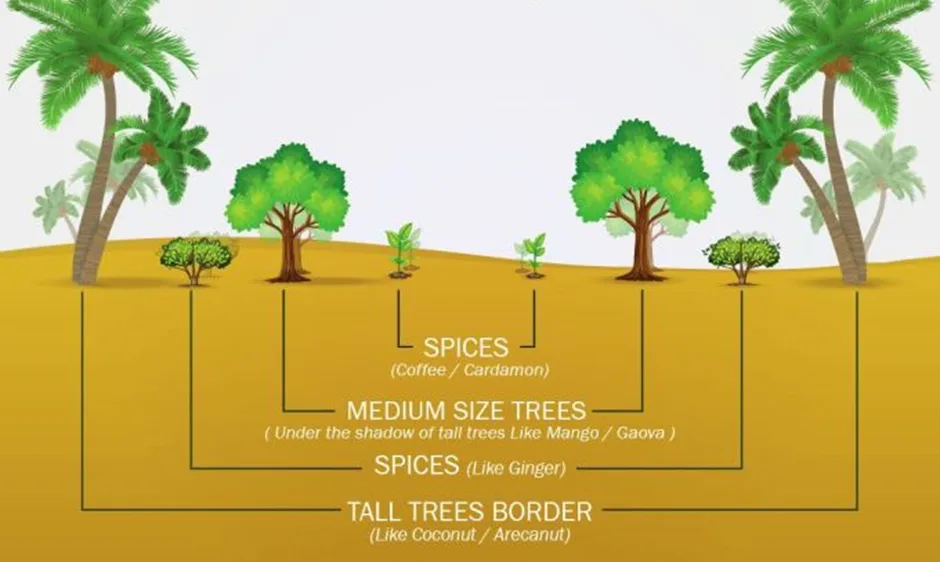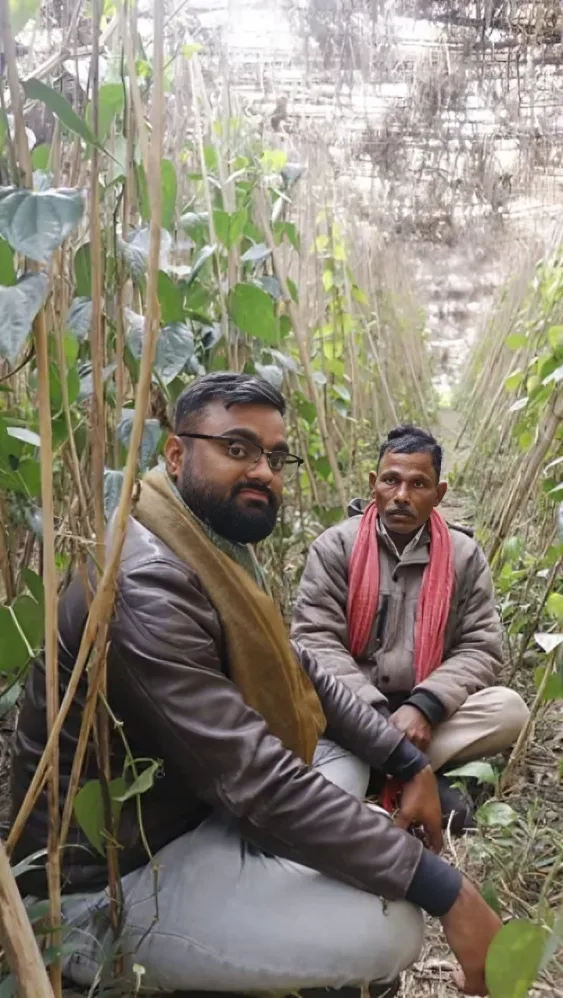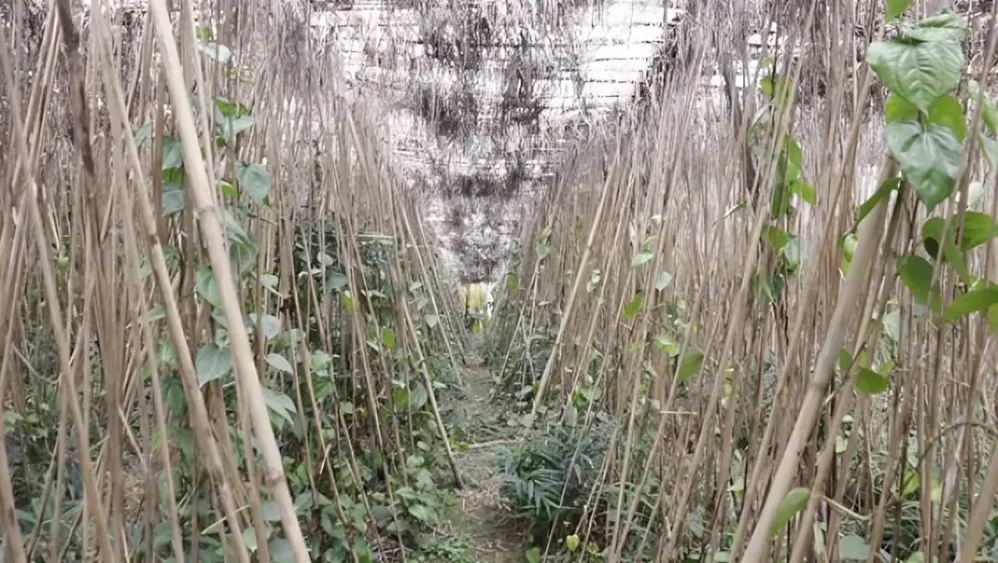Several crops are grown and harvested in a single field at different levels or heights using a farming technique called multilayer farming. This reduces competition for soil nutrients, increases soil cover and soil microbe diversity, and ultimately increases field yield with little to no need for external nutrient supplements. This type of farming is also known as “vertical farming” since the plants vary in height and are planted with a certain amount of space between each other. Additionally, the field fosters a favorable crop-growing environment by reducing plant competition for nutrients in a small area. This farming system is known for supporting farmers by offering year-round productivity, guaranteeing a steady income, and generating new revenue every season.
It is a method for optimizing land use and improving soil quality, as well as growing several crops in the same field and then using the remnants of the previous crop as fertilizer for the current crop. For example, radish, beans, and sweetcorn/cucumber. Radish helps to supply nitrogen to the soil while preventing erosion and runoff. Beans aid in nitrogen fixation and contribute to reduced greenhouse gas emissions. Sweetcorn is a small-scale and part-time crop with cheap investment and excellent profits. Finally, cucumbers are renowned as a natural repellent, and a farmer can earn a lot of money from a cucumber harvest in just 120 days. This approach occasionally coexists with animal husbandry, such as poultry, fish ponds, duck farming, etc.
Components
Ø Trees:
Trees are one of the components. They might be big, medium-sized, or small. As leaves, fruits, and Nuts Drop, Fruit Trees, Nut Trees, Rubber, Coconut, and different types of Oil Palms appropriate for the top canopy offer shade and organic matter inputs. Coffee, Cocoa, and slower-growing timber species all grow well beneath the main canopy when there is enough light to reach them. Other trees including Guava, Mango, Tamarind, Teak, Cinnamon, Bamboo, Eucalyptus, and Neem, as well as fruit trees.
Ø Medium height crops (Shrubs):
The semi-shaded lower levels can support the growth of medium-length crops with a small amount of sunshine. Numerous vegetables, Fodder Crops, Papaya, Bananas, Moringa, Rice, Wheat, Maize, Grams, Mustard, and other medicinal crops like Tulasi, Mint, Brahmi, and Aloe are among the crops.
Ø Vines:
Climbing vegetables including Tomato, Cucumber, Pumpkin, Watermelon, Muskmelon, Beans, Pepper, Grapes, and other medicinal crops like ivy, ashwagandha, jasmine, and wild yam are known for their climbing qualities. By hanging to nearby supporting trees, they use the available vertical space. They occasionally rely on the field-built fences for support.
Ø Rhizomes, or ground crops:
Ground crops develop underground and make use of the available space to grow unhindered, including Turmeric, Ginger, Garlic, Onion, Potato, Sweet Potato, Yam, Beetroot, Radish, Carrot, And Turnip.
Ø Livestock:
Livestock helps recycle nutrients in the fence at the soil level. Felines such as pigs, goats, cows, and hens consume leaves that have fallen, weeds, and leftovers from farming. Manure helps to naturally fertilize the soil and enrich it with nutrients.
Ø Aquaculture:
Aquaculture Integrated fish ponds or tanks use manure from cattle to create aquatic food that is high in protein. Indian carp, Catla, Hilsa, and Rohu are a few of the swiftly reproducing freshwater species that can be raised.

Model of Multilayer Farming
Steps to perform multilayer farming
Ø Selection of crops
Choosing the appropriate crops is crucial for both conventional farming and the multilayer model. However, in this case, it is important to choose a variety of crops and to carefully plan which crops to plant and where to put them so that the plants will support one another during their growth cycle. The crops must be chosen with consideration for the farm’s soil type and seasonality in mind. For the crops to be highly productive and easily adapt to their surroundings, the best local varieties are typically advised.
Ø Field preparation
Basic practices such as plowing, tillage, leveling, FYM addition, and composting are required in this model. Same as conventional farming this method also needs a basic well well-prepared field to help the control growth of weeds, promote plant nutrients, and help in direct seeding.
Ø Seed selection and treatment
Selecting the high-quality seeds of various crops and performing the required seed treatment to protect them from seed-borne or soil-borne illness. This helps to generate a pure, healthy, vigorous seed which helps in high yield potential is ideal.
Ø Irrigation
Irrigation is one of the most crucial factors in plant growth. It is critical to meet the requirements for transpiration and photosynthetic activity. Water is used to dissolve the nutrients present in the soil so that plants can absorb the nutrients easily. Irrigation in multilayer farming is not too much needed as the crops can use the rainfed water to the full extent.
Ø Weeding
Usually, the multilayer farming model doesn’t support weed growth on the field thus, the field requires minimum weeding practices if needed once in 3-4 weeks.
Ø Post-harvest
After the harvest produce can be value addition. Post-harvest processing ensures the preservation of quality, extends shelf life, reduces losses, adds value, promotes food safety, and opens up new market opportunities for farmers.
Advantages
Ø Overall yield:
When crops are planted in an area that is conducive to competition, the total productivity per unit rises, which in turn raises the overall yield and the farmer’s revenue. This is accomplished by growing complementary plants using the vertical space in the field. By reducing the amount of agricultural land needed to meet food demands, more natural habitats and ecosystems can be preserved.
Ø Land conservation:
By using vertical space to grow more crops in less land areas, this farming technique lessens the demand for expanding land and protects ecosystems and natural habitats.
Ø Soil fertility:
By establishing a nutrient cycle in which the nutrients taken up by the crop are recycled back into the soil by the leaf and fruit drops that fall to the ground and decay, the multilayer farming system functions as a biome unto itself. Decomposition results in a rise in soil microbial density, which raises soil fertility in the long run.
Ø Soil runoff:
Plants with high soil occupancy will reduce soil runoff. Because, multilayer farming uses less water overall, all of the plants on the field make full use of it. Long-term soil structure is maintained and fertile topsoil loss is avoided as a result.
Ø Pest control:
The controlled conditions aid in stopping the spread of pests, thereby lowering the requirement for pesticides. Crop protection and management are further aided by vertical crop planting. Pests are known to be kept out of fields by natural repellents including Basil, Marigold, Garlic, Onions, Mint, Chrysanthemum, Chives, Chilli Peppers, Oregano, Lavender, Rosemary, Thyme, etc.
Ø Weed control:
Since there is a high plant density in the field, the model itself helps to reduce the weed density because the weeds would not be able to find a place to grow. Weed density is negligible or unnoticeable because the environment is too competitive for weeds to flourish and spread freely.
Ø Diversified income streams:
The farmer makes the most of the space by growing a variety of crops in one accessible space. The system may require more initial input costs, but with time it transitions to an agroforestry system, requiring comparatively less input in the field and increasing production annually. The farmer’s income is stable because he grows crops that yield results in two to three months, as well as annual and perennial crops in the same field.
Ø Microclimate:
By producing a microclimate that is ideal for several crop varieties, multilayer farming maximizes the growth environment. The quality and yield of crops can be enhanced by controlling the temperature, humidity, and light intensity. The approach turns into a form of agroforestry, which benefits all of the field’s crops.
Ø Reducing greenhouse gases:
This approach reduces its carbon footprint by using irrigation water more efficiently and using less chemical-based insecticides and fertilizers. Because the model absorbs greenhouse gasses from various sources, including rye, buckwheat, clover, peas, lentils, chickpeas, beans, oats, millets, sunflower, etc.,
Ø Climate resilience:
Extreme weather events like droughts and floods are protected against in controlled areas. Regardless of the external climate, farmers can still sustain steady production. This model is an example of an agroforestry model, which uses rainwater absorption to replenish groundwater reserves and stop water from evaporating. The model’s trees reduce the likelihood of floods by preventing rain from falling directly on the ground. Like plants use groundwater during droughts, they can withstand the conditions to some extent. Compared to typical agricultural fields, this field is more equipped to withstand floods and droughts because of the variety of crops grown there.
Ø Year-round production:
A steady supply of food is ensured because the model’s production is continuous, meaning it occurs all year long. While perennial trees spend more time on the field than seasonal varieties do, seasonal varieties spend less time there. While annual and perennial crops make up the majority of a farmer’s profits and income, seasonal types guarantee a steady flow of money.
Ø Resource efficiency:
By minimizing waste and promoting sustainability, this method makes better use of the water and nutrients that exist within the field without depleting any resource. It even conserves water resources and makes effective use of irrigation water.
Ø Crop diversity:
In the small area that is accessible, the farmer can cultivate a variety of crops, building resilience and biodiversity in the food chain. Among the most widely employed techniques in the model to preserve soil health and boost crop productivity are crop rotation and intercropping.
Ø Livelihood:
Farmers benefit economically from multilayer farming since it increases crop yields and diversifies product offerings. ensures sustainability and a steady income for the nation’s small and medium-sized farmers.
Challenges
Ø Knowledge
The knowledge of a farmer regarding what is best for himself and his land is always up for debate. However, this approach is challenging to begin with but simple to maintain if the farmer is prepared to acquire the finest techniques for managing his field organically. Ultimately, a farmer is a more knowledgeable and adaptive person than anyone else.
Ø Ability to manage
It is challenging to oversee everything by oneself because the model’s field contains a variety of crops. To achieve the optimum results, a farmer must be able to control the biological balance, integration, and temporal intensity of their fields. However, the farmer can always take the assistance of specialists from time to time to help prepare a diverse crop for the farmer.
Ø Production management
After the project, it may take two to three years for the perennial crops to reach their maximum output potential and for the system to settle. Until then, the model is incomplete because it only includes the medium and small crops. The farmer cannot grow plants in the field that require shade until the perennial crops have grown to the point of canopy formation.
Ø Infrastructure cost
The infrastructure cost is huge since installing the irrigation systems, labor capital, and support fence for the climbers may require a large initial expenditure from the model. However, once prepared, it has a 5–9 year average life span and requires less attention after 2–3 years.
Ø Labor intensive
Compared to conventional farming, systems including numerous vertical levels and increased crop density require greater manual labor inputs per unit of land area.


Smaller crops are protected from severe weather by natural barriers including Maize, Sorghum, Bamboo, and Eucalyptus. These barriers also ward off violent winds and hail. These towering crops create a microclimate that is beneficial to other plants by offering much-needed cover and protection. On the other hand, plants like Moringa, Grapevine, Pigeon Peas, and Sunflowers form a canopy that offers protection and shade while also assisting in the retention of soil moisture for smaller plants. These crops support a healthy environment by allowing plants to flourish in hot, dry weather. Furthermore, crops including Millet, Alfalfa, Buckwheat, Sun Hemp, Oats, Barley, and Buckwheat are essential for replenishing soil carbon. These crops improve the fertility and health of the soil by adding organic matter. Soil erosion may be effectively reduced by crops including Soybeans, Rye, Oats, Barley, Wheat, Sorghum, Millet, Buckwheat, and Field Peas. In addition to improving soil fertility, they shield the soil’s surface from wind and water erosion and stabilize it. By enhancing agricultural yields, fostering biodiversity, and strengthening soil health, these crops work together to support sustainable agriculture. The productivity and resilience of agriculture over the long run are supported when these crops are included in farming systems.
Since perennial tall trees require at least two to three years to reach their full height, the field should be planted with perennial tall trees first. After two to three years, shade-loving plants can be added. Later on, the huge and medium-sized trees won’t get overly crowded because they will have enough space to flourish. Consider the size of the tree’s canopy when it reaches maturity. Think about if the trees surrounding it should be harvested or planted at all, or if they will likewise grow tall and wide. Crops are arranged in all directions: vertically (all planting spaces occupied), horizontally (all tall, medium, and short plants fit together), and underground (both shallow- and deep-rooted plants). Planning is necessary for any farming system to spread labor and money throughout the year and diversify products. Within three to four months of planting, the first crops yield food or cash. Select crops that yield cash income in addition to subsistence goods. Plant trees that produce a variety of fruits throughout the year. For the first several years, a multistory agroforest will alter annually due to shifts in labor needs and product offerings. For the farmers, this will provide a consistent cash stream throughout the year.
A healthy and balanced ecosystem requires the interconnected elements of land conservation, yield enhancements, climatic resilience, environmental protection, and sustainability promotion. By making land conservation a top priority, we can stop land degradation and protect natural habitats, which benefits biodiversity and the planet’s general health. Increases in agricultural yield, attained by environmentally friendly methods like crop rotation, organic farming, and precision agriculture, improve food security and reduce environmental damage. Adaptive practices ensure the sustained production of land and resources by assisting communities in coping with and recovering from extreme events and changing weather patterns. This builds climate resilience. Reducing pollution, saving water, and preserving wildlife habitats are all parts of environmental protection, all of which advance sustainability as a larger objective. When combined, these initiatives support a future in which human needs are satisfied without jeopardizing the health of the earth and its ecosystems.

